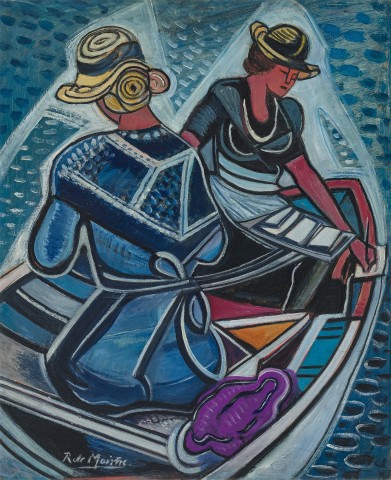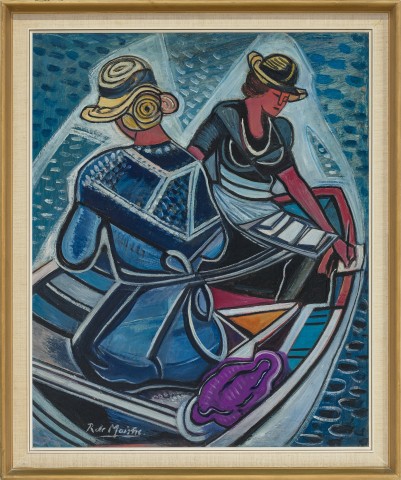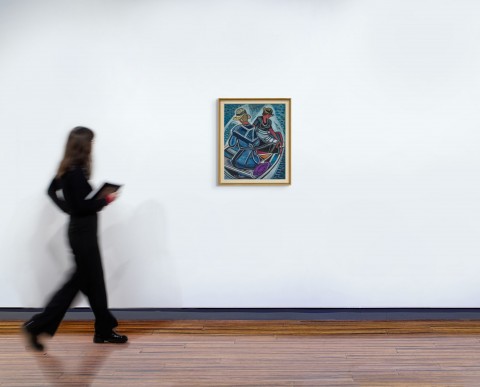(1894 - 1968)
Roy De Maistre
Two women in a boat, c.1935
oil on board
Miss Doris de Mestre Fisher, United Kingdom, acquired directly from the artist
Thence by descent
Caroline de Mestre Walker, United Kingdom
Two Women in a Boat, oil on board, 59.0 x 49.5 cm, private collection, illus. in Johnson, H., Roy de Maistre: The English Years 1930 - 1968, Craftsman House, Sydney, 1995, pl. 15, p. 38
Caroline de Mestre Walker has been co-copyright holder on de Maistre’s work since 1975 and has generously donated her Roy de Maistre archive and papers to the Art Gallery of New South Wales.
An attractive and sophisticated painting, Two women in a boat, c. 1935 exemplifies well de Maistre’s approach to his art, demonstrating his interest in colour and abstracted design. Notably, the painting is a stylised version of a more realistic work, Two Women, 1934 (private collection) and although the subjects here are not named, the composition almost certainly depicts Lady Ashbourne and a companion boating on the river in Compiègne, France. Previously it has been suggested that the second figure is Violet Gibson, Lady Ashbourne’s sister-in-law who achieved notoriety by attempting to shoot Mussolini in 1926, however there is no evidence to support this supposition. Indeed, Violet Gibson was visiting the Ashbournes in 1924 and de Maistre could conceivably have met her, but by 1934, she was housed in a mental institution. Moreover, the painted image bears no resemblance to photographs or descriptions of Violet made at this time.1
After gaining a reputation as an early ‘modern’ painter, de Maistre left Sydney in May 1923 to take up the informal overseas study awarded by the Society of Artists Travelling Scholarship, spending the next two years in Europe, mainly France. A photograph sent to his sister in Sydney during this trip shows the artist seated at the gate of the home of Lord and Lady Ashbourne in Compiègne, France.2 It is not known how de Maistre met the Ashbournes, but Lord Ashbourne (William Gibson) and his wife Marianne (née Marianne de Monbrison) became close friends and the subjects of many of de Maistre’s works which feature the couple relaxing at home or enjoying activities on the nearby river. While Lord Ashbourne, an extremely colourful figure – philosopher, religious scholar and linguist who gave his maiden speech in the House of Lords in Gaelic and commonly dressed in a saffron kilt and espadrilles – has been depicted enthusiastically rowing or actively writing, depictions of Lady Ashbourne typically reveal her engaged in quieter pursuits such as reading, painting or knitting. In the more realistic version of this work, the figures are static – enclosed in a not easily readable but intimate space. They are simultaneously engaged by their proximity and confinement and disengaged by their self-absorption and posture – looking in opposite directions and individually reading.
De Maistre regularly made several versions of his works, often stylising a more realistic version. In the present Two Women in a Boat, de Maistre has converted the women’s surroundings to be more obviously a boat, yet at the same time he has flattened and abstracted the scene, emphasising the separation between the figures by framing them in pale triangles and adding decorative elements, particularly related to shape. The lightly depicted decorative pattern on Lady Ashbourne’s shawl has been hardened to geometric motifs, while the ‘pages’ of the second figure’s reading or drawing material have been changed to panels reminiscent of the colour stripes of de Maistres later colour music paintings, and Lady Ashbourne’s hair bun and hat have been turned into concentric circles echoed in her companion’s hat. The space surrounding the figures is similarly sharpened by rectangles and triangles, mostly to the right and left of the foremost figure. De Maistre’s colour expertise is subdued in this work. His dominant use of shades of blue is contrasted by the touches of yellow in the hats and the reddish skin tones of the subjects, thus adding balance and stability to the scene. Although the figures are seated in a rowing boat, there is no movement – only the serenity of a closely shared, yet at the same time, individual, experience.
1. See Stoner Saunders, F., The Woman Who Shot Mussolini, Faber and Faber, London, 2010, Chapter XI
2. Reproduced in Johnson, H, Roy de Maistre. The Australian Years, Craftsman House, 1988, p. 43
DR HEATHER JOHNSON


